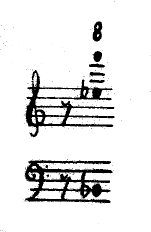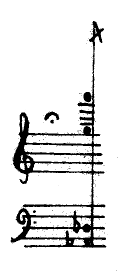I’ve been playing Feldman’s Intermission 6 lately. Composed in 1953, this is the last of the Intermission series. The score is a single page with fifteen bits of music scattered across it. I can’t reproduce it here for copyright reasons, but you can get an idea of what it looks like from the photo on my post from 10 October 2010. Each bit of music is a single attack: either a chord, a single note, or an octave.
Feldman provides the following instructions:
Composition begins with any sound and proceeds to any other. With a minimum of attack hold each sound until barely audible. Grace notes are not played too quickly. All sounds are to be played as soft as possible. This “Intermission” may be played with either one or two pianos.
In playing this piece, a couple of questions appeared pretty quickly: Can you repeat any of the sounds? and how long the piece should go on? Feldman gives no clue in his instructions. Personally I allow for repeats of the sounds, and I keep playing until I’ve had enough. I could also just decide on a particular duration ahead of time (you’d probably have to do this if you were doing it with two pianists).
As with any Feldman piece, I think, there are exceptions to his rules, and the notation of the individual sounds themselves require some interpretation. Mostly they are just simple stemless noteheads. But a couple include rests:
I believe this means that there will be a short pause before this sound, which interrupts the decay. When I play the above sound, I do not let the previous sound decay fully, but release it while the sound is still (barely) audible, so that the rest is clearly articulated. Another sound includes a fermata:
I assume that the fermata is over an implied rest: that this indicates a longer pause before the grace note sound. The grace note itself, as Feldman indicates, is “not played too quickly”, but it also assumes, then, that this sound is not allowed to decay, but instead goes directly to the next sound. In other words, the grace notes are exceptions to the general rhythm of the piece. When I decide to play a grace note sound (there are two of them), I always look quickly to determine what the next sound after that will be, just so that I can execute the sequence fluidly.
The sounds themselves are quite simple. Six are chords, two are octaves, and seven are single tones. Most are in the middle and upper registers, which affects the rhythm of the piece: if he had included very low tones, these would have had much longer decays. The octaves are particularly beautiful. In no one else’s music are octaves as luminous as they are in Feldman’s.
As with Cage’s Two, part of learning this piece is figuring out how you’re going to make decisions about what to do next. In this case, how do you decide what sound comes next? Unlike with Cage’s work, determining the order randomly ahead of time is just not stylistically correct: that’s Cage’s way, not Feldman’s. So this is a case where I feel my way from sound to sound. I’ve tried just tracing paths across the score, making larger shifts from one point to another when I “fall off the edge” of the score. Another way I’ve approached it is to start anywhere on the score, play the sound, then either close my eyes or look down at the keyboard and just listen to the decay. Then I open my eyes and glance at the score again and play whatever my gaze lands upon next. This way my playing has a particular rhythm: attack, listening, preparing, attack again. I like that way a lot and have been mostly playing it that way of late. One thing that surprised me was when my glance landed on the same sound twice in succession: this was not something I had thought of before, and was a lovely effect.
In my way of playing it, then, Intermission 6 becomes a kind of meditation: I’m always listening to what’s happening right in front of me. The rhythm of the piece is determined by the decay characteristics of each attack. I have to listen to that decay, to really pay attention to it, in order to decide when it’s time to go to the next sound. So many conditions affect the rhythm of the piece: the nature of the sound (range, number of tones), my ability to play it as quietly as possible (sometimes successful, sometimes not), the amount of background noise in the room (when the refrigerator starts, “barely audible” has a different meaning). The piece is most successful for me when I’m able to really stay with the listening, not go off thinking about what patterns might be more or less interesting, etc. As with Cage, where one goes wrong is to inject too strong a sense of self into the performance. Stay open and actively listening and the performance will go well. Intermission 6 becomes a slow rippling of the silence in the room, the sounds barely intruding and receding.
I’m thinking of recording this piece with Frances. We’ll decide on a duration and then each record it separately, then we’ll mix them together. Stay tuned for that (we plan to record Two sometime soon, too).



Great essay! Thanks for sharing your perspective on this enigmatic piece.
Sharing these insights is a lovely side effect of a community in which this Intermission yet outlives the gestures of work done today, over half a century later, emulating Feldman’s originality.